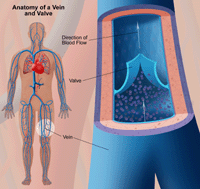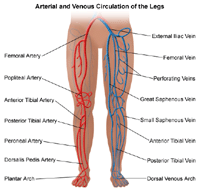Varicose Veins
What are varicose veins?
Varicose veins are enlarged veins that are visible through the skin and may appear as blue or purple twisted, knot-like cords. Varicose veins can occur anywhere in the body, but are more commonly found on the legs. Hemorrhoids, a type of varicose vein, can appear during pregnancy around the anus or in the vagina.
What are spider veins?
Spider veins, a milder type of varicose veins, are smaller than varicose veins and often look like a sunburst or "spider web." They are red or blue in color and are commonly found on the face and legs, just under the surface of the skin.
What causes varicose veins?
 |
| Click Image to Enlarge |
Varicose veins are caused by increased blood pressure inside the superficial leg veins. Two main types of veins are present in the legs. Superficial veins are near the surface of the skin, whereas deep veins are located in the muscle tissue. Varicose veins occur in the superficial veins in the legs. In contrast, deep veins lead to the vena cava, a large vein that transports blood to the heart.
The blood in the veins of the legs works against gravity in order to return upwards to the heart. The blood is moved up towards the heart by one-way valves in the veins. When the leg muscles contract and squeeze the deep veins, the valves inside the veins open. When the leg muscles relax, the valves close, preventing blood from flowing backward.
When the one-way valves become weakened or damaged, blood can collect in the veins, causing the veins to become enlarged. Sitting or standing for long periods can cause blood to pool in the leg veins, increasing the pressure within the veins. In persons who are prone to varicose veins, the veins can stretch as a result of increased pressure. This stretching of the veins may weaken the walls of the veins and damage the valves. Thick varicose veins or spider veins may result.
Other factors that may lead to weakened vein valves and the development of varicose veins include obesity, aging, leg injury, pregnancy, smoking, hormones, and heredity (being born with weak vein valves). While varicose veins are not considered a severe medical condition, they can be uncomfortable and can lead to more serious problems such as phlebitis (inflammation in the leg) or blood clot. Varicose veins can also be a cosmetic concern to some people.
 |
| Click Image to Enlarge |
Varicose veins, because they occur in superficial veins, are not generally linked to a serious condition called deep vein thrombosis (DVT). However, with severe varicose veins, there is a small increased chance of developing DVT. DVT requires immediate medical attention. Symptoms of DVT include sudden, severe leg swelling and can result in blood clots that travel to the brain or the heart.
What are the symptoms of varicose veins?
The following are the most common symptoms of varicose veins. However, each individual may experience symptoms differently. Symptoms may include:
-
color changes in the skin
-
sores on the legs
-
rash
-
sensations in the legs, such as a heavy feeling, burning, and/or aching
Severe varicose veins may eventually produce long-term mild swelling that can result in more serious skin and tissue problems, such as ulcers and nonhealing sores.
The symptoms of varicose veins may resemble other medical conditions or problems. Always consult your physician for a diagnosis.
What are the risk factors for varicose veins?
About 15% of adults in the US have varicose veins. The risk of varicose veins is strongly related to age and gender. The following are suggested risk factors for varicose veins:
-
obesityObesity is a major risk factor for varicose veins. Excessive weight increases the pressure on the veins of the legs and aggravates the condition.
-
family historyHeredity is important in determining susceptibility to varicose veins, but the specific factors responsible for this have not been identified.
-
inactivityProlonged standing or sitting increases pressure in the veins.
-
genderWomen are particularly susceptible to varicose veins because of the influence of progesterone on the veins and the effects of pregnancy. Women are 2-3 times more likely to have varicose veins.
-
pregnancyPregnant women have an increased risk of developing varicose veins due to the hormonal influences of pregnancy on the veins, but the veins often return to normal within one year of childbirth. Women who have multiple pregnancies may develop permanent varicose veins.
-
ageVaricose veins usually affect people between the ages of 30 and 70. With advancing age, the elastic shell of the vein begins to weaken increasing the chance that the vein will dilate.
A risk factor is anything that may increase a person's chance of developing a disease. It may be an activity, such as smoking, diet, family history, or many other things. Different diseases have different risk factors.
Although these risk factors increase a person's risk, they do not necessarily cause the disease. Some people with one or more risk factors never develop the disease, while others develop disease and have no known risk factors. But, knowing your risk factors to any disease can help to guide you into the appropriate actions, including changing behaviors and being clinically monitored for the disease.
How are varicose veins diagnosed?
In addition to a complete medical history and physical examination, diagnostic procedures for varicose veins may include any, or a combination, of the following:
-
venous duplex ultrasound - a type of vascular ultrasound procedure done to assess blood flow and the structure of the leg veins. The term "duplex" refers to the fact that two modes of ultrasound are used - Doppler and B-mode. The B-mode transducer (like a microphone) obtains an image of the vessel being studied. The Doppler probe within the transducer evaluates the velocity and direction of blood flow in the vessel.
-
magnetic resonance venography (MRV) - a diagnostic procedure that uses a combination of a large magnet, radiofrequencies, and a computer to produce detailed images of organs and structures within the body. An MRV uses magnetic resonance technology and intravenous (IV) contrast dye to visualize the veins. Contrast dye causes the blood vessels to appear opaque on the x-ray image, allowing the physician to visualize the blood vessels being evaluated. MRV is useful in some cases because it can help detect causes of leg pain other than vein problems.
Treatment for varicose veins:
Specific treatment for varicose veins will be determined by your physician based on:
-
your age, overall health, and medical history
-
extent of the condition
-
your signs and symptoms
-
your tolerance of specific medicines, procedures, or therapies
-
expectations for the course of the condition
-
your opinion or preference
Medical treatment may not be necessary if there are no symptoms. However, varicose veins may sometimes worsen without treatment. Treatment for varicose veins involves both surgical and nonsurgical approaches.
Nonsurgical methods for treating varicose veins include:
-
elevation of the legsYou may be instructed to elevate your feet above the level of your heart three or four times a day for about 15 minutes at a time. If you need to sit or stand for a long period of time, flexing (bending) your legs occasionally can help keep blood circulating. If you have mild to moderate varicose veins, elevating your legs can help reduce leg swelling and relieve other symptoms.
-
compression stockingsThese elastic stockings squeeze or compress the veins and prevent blood from flowing backward. In addition, compression stockings may help with healing of skin sores and prevention of additional sores. Compression stockings are effective in treating varicose veins if worn daily and may prevent the need for more invasive treatment.
-
sclerotherapySclerotherapy is more commonly used as treatment for spider and smavaricose veins. This procedure involves a saline or chemical solution that is injected into the varicose veins that causes them to harden so that they no longer fill with blood. Blood that would normally return to the heart through these veins returns to the heart by way of other veins. The veins that received the injection will eventually shrivel and disappear. The scar tissue is absorbed by the body.
-
laser or radiofrequency catheter ablationThe physician inserts a tiny fiber into a varicose vein through a catheter. The fiber sends out laser energy that destroys the diseased portion of your varicose vein. This causes the vein to clot, scar, and shrink. High radiofrequency energy can also be delivered by a catheter inserted into a varicose vein. The tip of the catheter heats the walls of the varicose vein and destroys the vein tissue. Once destroyed, the vein is no longer able to carry blood and is absorbed by your body.
Surgical approaches to the treatment of varicose veins include:
-
vein strippingThis procedure involves tying off all varicose veins associated with the leg's main superficial vein and removing it from the leg. The removal of veins from the leg will not affect the blood circulation in the leg as deeper veins will be able to take care of the increased blood circulation.
-
small incision avulsionThis procedure involves passing hooks through small incisions, and may be done alone or together with vein stripping or laser/radiofrequency catheter treatment.
-
transilluminated powered phlebectomyThis vein removal procedure makes use of a bright light to illuminate the vein. A device is passed through a tiny incision and removes the vein with suction.
Preventing varicose veins:
Steps to prevent varicose veins include maintaining a healthy weight, exercising regularly, and elevating the feet while sitting. Avoid clothing that constricts your waist, groin, or legs, shoes with high heels, and crossing the legs while sitting. While these measures may help prevent varicose veins in some people, they may only slow the onset of the condition in individuals who are susceptible.
Click here to view theOnline Resources of Cardiovascular Disease